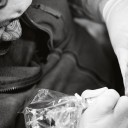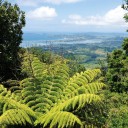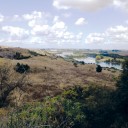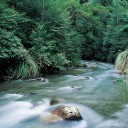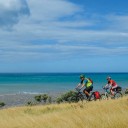
Hikoi
Two tribes retrace ancient paths
Here, among rimu and totara on top of one of the highest ridges in the East Cape’s Raukumara Ranges, the day’s last sunlight is filtering through the campfire smoke. Scarcely noticing, the young people are raucously telling jokes. An elder interrupts gently. He poses a question.
Have they ever heard the sun walking through the leaves of the trees? he asks. The young ones are puzzled. Heard? Yes, heard. You see that sun, he asks. Yes, we see it, they say, baffled. If they listen well enough, the elder says, at the absolute point of quietness they will hear the sun walking through the leaves.
Eyes shut, their faces screwed up with absolute concentration, the young people listen. Three or four minutes go by before one of them opens his eyes suspiciously, catching the elder suppressing his mirth.
“You’re a dreamer, uncle,” he says sheepishly.
[chapter break]
The point has been made, though, the lesson received. Out here, surrounded by virgin bush, there are times when quietness and reflection are needed to absorb the lessons of sunlight, trees, water and land. And to think on the meaning of the journey that lies behind and ahead.
There are 54 in the hikoi. For each of them, this march represents a walk through the pages of their personal history.
All bar a few are from the predominant East Cape tribe, Ngati Porou, and nearly all descended from one eighteenth century Ngati Porou chief, Umuariki, from Tuparoa near Ruatoria. Hundreds of years ago, Umuariki used this trail to visit his granddaughter who had married into the family of Rutaia, a chief of the Whanau-a-Apanui, the tribe on the other side of the Cape.
The hikoi’s mission, in 10 days, is to re-cross the rugged ranges of the Cape’s interior, retracing the footsteps of Umuariki to re-establish those family links forged centuries ago. At the end of the trail, at Otuwhare marae, the Whanau-a-Apanui people will be awaiting them.
A year earlier, Rutaia’s descendants had made the first journey across the throat of the Cape to visit their relatives. The message they brought with them was putahitanga—the drawing together of families and tribes. This Ngati Porou response will close the circle between the two families, strengthening their bonds in the face of an uncertain future.
The 54 have returned home from all over the country for this journey; one has come from Australia. The youngest, Anthony McClutchie, is 10 years old. Tame Te Maro, 64, is both the oldest member of the group and the senior Ngati Porou kaumatua for the hikoi. Knowing that the path ahead would be tough, with over a hundred river crossings and 3000-foot ranges to traverse, he has trained hard to prepare himself.
Some of the others—young city slickers who have never been in the bush before—now know what being unfit feels like, after slogging their way up 3200 feet to this, their first camp. For the rest of the journey they will live as their elders who came before them did—hunting and gathering food from the bush, walking the same paths their forebears walked, sleeping where they slept.
Already they have learned one sharp lesson. During the strenuous climb they have finished all their water—and the extra water brought in by the hunters. Tonight they will go to sleep thirsty, but tomorrow, when they reach the Raukokore River, they will appreciate water as they have never appreciated it before.
That night, as they drift into tired sleep, they hear sounds unchanged from hundreds of years ago: the westerly wind soughing through the canopy high above, the short harsh calls of the North Island brown kiwi. They are sounds which most of them have never heard before.
[chapter break]
The Raukokore catches the headwaters of the Raukumara Ranges, the mountain backbone which cleaves the East Cape, and is regarded by some as the dividing line between Ngati Porou on the eastern side and Whanau-a-Apanui to the west. Others disagree, saying that when the damp sea breeze from the Bay of Plenty side licks your face as you come over the highest point of Te Ranginui a Toi, that is the boundary between the two tribes.
The debate is not new. Legend has it that there used to be a boulder on the hill marking the boundary. At various times, one or other of the tribes would creep up and push the stone one way or the other. One day, so the story goes, one of the tribes decided to lie in wait and catch the other tribe in the act of shifting the boulder. And when they did, suddenly, the stone flew through the air and out to sea, landing in deep water off Lottin Point. Should anyone now try to shift it, the story warns, they will be drowned.
Te Whanau-a-Apanui was formed by a group of families on the western side of the Raukumaras in about the 1300s. It was a turbulent time, when fledgling tribes jostled for power and great warriors strode the land. It was a time when male babies were dedicated to the war god and raised in the martial arts—the use of taiaha and mere—and in survival techniques. They were taught to read the signs of the bush to track their enemies, and to use trance to last days in the bush without food or water.
Through these mountains, the warriors of Ngati Porou and Te Whanau-a-Apanui sped on their way to do battle with each other. All along the trail the place names speak of those days, distilling the history of the trail: “the place where hundreds weep”, “the place where the greenstone mere are sharpened”, “the place where final meals before battle are eaten.”
Raukokore itself, explains Tame Te Maro, means the hundreds of warriors who became nothing. Right along this river were Ngati Porou pa, their first line of defence to stop marauding Te Whanau-aApanui from reaching the large settlements further south at Ruatoria.
Over the centuries, the trail’s purpose gradually changed. From a war trail it became a trail of courtship. It was during this period that Umuariki—the ancestor whose footsteps are being retraced by this hikoi—would have walked the trail to see his mokopuna at Otuwhare, timing his visit to coincide with the harvest rains, with the ripening of berries, and with the fattening of the birds. Along these paths too, in the 1830s, the London Bible Society’s Rev. William Williams, later to become the Bishop of Waiapu, carried Christianity to the Cape.
Now, there are signs that tourists are invading the trails. On the descent to the Raukokore the group has found a Polish tourist’s initials carved on one of the rata trees. It is a warning to the tribes to guard access to these historically rich paths.
[chapter break]
By the fifth day, the rhythm of the trek is becoming established. Each morning and evening, elder Keepa Stirling insists on haka practice—sometimes at dawn in the chilled river waters. If the performance is not good enough, he makes the group do press-ups in the water. Some of the participants have pigged out in the first few days and eaten almost all their rations, while others, sensing shortages ahead, have carefully conserved theirs. Tempers fray as people realise that the food they have brought will not go the distance without being shared and supplemented.
Individual strengths are seen in a new light, and the bushmen in the group have taken on an importance they could never have in a city. A pig is caught, and then another, and as the group makes its way along the Raukokore, some turn their hand to eeling.
Those who don’t have the heart for killing, but still want to eat the end result, realise they will have to barter for their share. One offers to act as porter for the group’s guitar, lugging it over mountains and across rivers.
This morning, at the start of the day, they share in the task of building a hangi to cook the meat they have killed, the puha and pikopiko fern and supplejack shoots they have picked from the bush. Together they weave the food baskets from flax, and lay ponga ferns over the stones to keep the food clean. No sacks, no shovels here.
Later, on the trail, the group encounters its first log jam. Like a handful of giant’s matchsticks thrown carelessly into the canyon, the logs, piled up over hundreds of years and locked between the high walls of the river gorge, have formed a 50-foot wall of danger. They are slippery and treacherous, and as one of the group puts his weight on a log it suddenly shifts under him, threatening to slide logs down on to those below. Hikoi organiser Joe McClutchie calls his leaders together to form a human staircase up the jam. Strong arms are placed at strategic points to help climbers unbalanced by the heavy packs they carry. “I want you to crowd it so that the others feel safe and can’t see the drop below them,” he tells the leaders.
Today, their aim is to reach what for many will be the climax of the track, a waterfall called Wai Tapu Toa. It was to this waterfall that Te Whanau-a-Apanui warriors would return after battle for physical and spiritual cleansing.
The days of exhaustion seem to slip away as the group comes closer to this sacred spot. In the late afternoon they enter a canyon only an armspan wide in places, and as high as a ten-storey building. The walls are cloaked in a green moss, and through it, creeping slowly down the walls, are millions of shimmering droplets. Like nets of diamonds, the trembling drops catch the sun, shattering it into shards of light which flicker over the walls of the chasm.
There is no escape from such a place—no way up, no way down, only one way in, and one way out. It is the perfect place for an ambush. In this chasm hundreds of this group’s forebears would have met their deaths, their bodies left to lie where they were slain.
At dusk, the keening cry of a karanga drifts down the valley, calling the group to Wai Tapu Toa. It is a struggle to reach the waterfall through the tangled chaos of trees and boulders which block the path. But when the group files into a small clearing at the base of the waterfall, it is as if a gardener has been at work every day since their ancestors gathered here hundreds of years ago. Every rock looks as though it has been carefully placed; every plant seems immaculately groomed.
Here, Keepa Stirling explains, the tohunga from Te Whanau-aApanui waited for their warriors to return from their forays. This is where the men had their wounds bathed, where prayers were offered, and where the tapu placed on the men for their fighting was lifted.
Those here today try to picture that scene. How many tohunga would there have been? What volume of noise—the noise of prayers—would have filled this space? How much blood would be flowing? Enough to colour the small stream red? And suddenly the place becomes more than rocks and water. For the hikoi members are connected to both sides of these ancient conflicts—some of today’s party are descended from the returning warriors, others from their victims.
There are hard days—the hardest—of tramping ahead to reach their relatives on the other side, but for many, the experience of this night will carry them through.
[chapter break]
Over the last few days since they left Wai Tapu Toa, the hikoi has travelled over more mountain ridges and slogged through a whole day of log jams—more than 30 of them in a solid chain. They have roped their way up cliff faces and through waterfalls. The food rations have dwindled, and with the combined effects of lean diet and unaccustomed exercise, most have lost a substantial amount of weight.
Today, the ninth day, they have faced the longest slog of all, a 12-hour tramp. This piece of the trail is their own special leg—the section where Umuariki would have left the main trail to branch off in a westerly direction towards his family at Otuwhare. The way is so tiring for some that at every stop they fall asleep on the ground, even if only for a few minutes.
And now, as the Ngati Porou group wearily drag themselves into their campsite, the scene they stumble into bewilders them.
Without the group knowing, Te Whanau-a-Apanui has brought food up a four-wheel drive trail for a hangi. While the marchers have been struggling along the last two hours of the route, Whanau-aApanui scouts have been checking their progress, and have now melted off to their homes to let the food alone welcome their visitors.
Wonderful food, Whanau-aApanui food: traditional kahawai, modern sweetcorn, flat bread and pounds of butter. The sort of food the group felt they might never see again. But even as the young ones fall on the feast, the Ngati Porou elders wryly note that, really, they’ve been aced. Full stomachs make easy prey. As well as being a welcome, this is a little joke from the opposite hapu. This is the equivalent of a yesteryear ambush.
[chapter break]
The end of the trail is just out of sight down the valley as the group stops for a final brew-up. For the first time on the journey, the rain is starting to fall—an auspicious sign symbolising the presence of the ancestors.
Cracks of thunder roll and echo off the high hills around. Then, in a moment of quiet in the storm, the grieving cry of a karanga drifts up the valley: the beckoning call of waiting families, fuelling the group’s longing to be reunited. It is a call which must be hurriedly met—if it is not swiftly answered, tradition says, there will be a death.
The campfires are quickly extinguished, packs shouldered. Now, with the rain, the whole look of the hikoi has changed. With packs and gear under yellow raincapes, only stick-like legs showing, the misshapen marchers look like aliens.
They set off in a ragged shamble down the hill. As they come to the river and catch sight of their families waiting for them across the other side, the marchers are all sobbing. Then the sobbing is drowned by the ferocity of their haka—a haka honed and made potent by the experiences of the journey.
With families united, the whole group moves on to the hikoi’s ultimate destination: Otuwhare marae, the home of Rutaia’s descendants. Their arrival will not only symbolise a resolution of past battles in a New Zealand many have forgotten, but also become a preparation for future struggles in a New Zealand most of us still can’t quite see.









